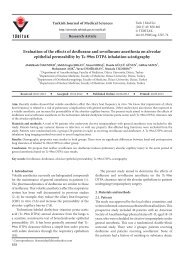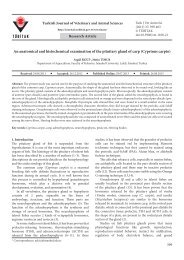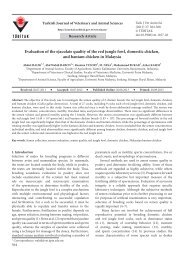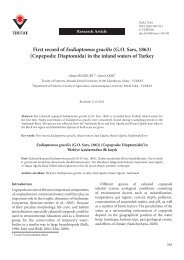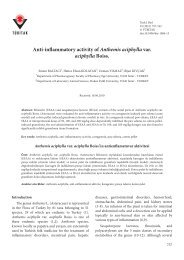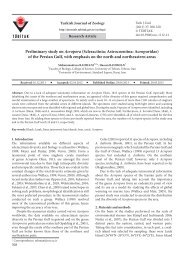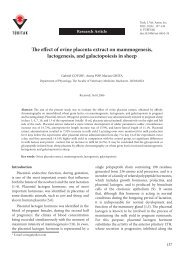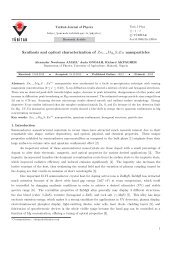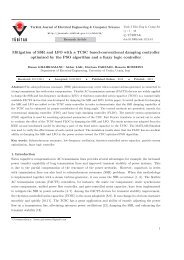A new Barrussus Roewer, 1928 - Scientific Journals - Tübitak
A new Barrussus Roewer, 1928 - Scientific Journals - Tübitak
A new Barrussus Roewer, 1928 - Scientific Journals - Tübitak
Create successful ePaper yourself
Turn your PDF publications into a flip-book with our unique Google optimized e-Paper software.
Turkish Journal of Zoology<br />
http://journals.tubitak.gov.tr/zoology/<br />
Research Article<br />
Turk J Zool<br />
(2013) 37: 594-600<br />
© TÜBİTAK<br />
doi:10.3906/zoo-1202-16<br />
A <strong>new</strong> <strong>Barrussus</strong> <strong>Roewer</strong>, <strong>1928</strong> (Solifugae: Karschiidae) from southern Turkey<br />
Ayşegül KARATAŞ 1, *, Münir UÇAK 2<br />
1<br />
Department of Biology, Faculty of Science & Arts, Niğde University, Niğde, Turkey<br />
2<br />
Department of Biology, Ankara University, Ankara, Turkey<br />
Received: 11.02.2012 Accepted: 09.05.2013 Published Online: 12.08.2013 Printed: 06.09.2013<br />
Abstract: A <strong>new</strong> species of <strong>Barrussus</strong>, <strong>Barrussus</strong> telescopus sp. nov., is described from the Bolkar Mountains in southern Turkey. Males<br />
have an extremely elongated and bar-shaped ocular tubercule extended anteriorly between their eyes, which is the longest projecting<br />
ocular tubercule among all known males of <strong>Barrussus</strong>. The ocular tubercule of females has a short conical projection. Cheliceral<br />
movable fingers of type specimens have 5 anteriorly situated small teeth. Males have club-shaped ctenidia on the 4th and blunt-ended<br />
tubular ctenidia on the 5th opisthosomal sternites. The female has no ctenidia on its 4th opisthosomal sternite, with ctenidia on the 5th<br />
opisthosomal sternite similar to that in males. Ctenidia of the 5th opisthosomal sternite are pointed apically in the female, blunt in the<br />
male. The female possesses a hump-like projection on the metapeltidium, which is only known from females of B. telescopus sp. nov.<br />
within all known females of <strong>Barrussus</strong>. The <strong>new</strong> species is differentiated from B. pentheri (Werner, 1905) and B. furcichelis <strong>Roewer</strong>, <strong>1928</strong>.<br />
Key words: Solifugae, Karschiidae, <strong>Barrussus</strong> telescopus, <strong>new</strong> species, Turkey, Bolkar Mountains, Niğde, morphology<br />
1. Introduction<br />
The order Solifugae is divided into 12 families, and 1110<br />
species have been described to date (Blick and Harvey,<br />
2011).<br />
Werner (1905) described Rhinippus pentheri from<br />
Mount Erciyes (Kayseri Province) between Ereğli (Konya<br />
Province) and Bor (Niğde Province), with 2 males and 3<br />
females, under the <strong>new</strong> genus Rhinippus. <strong>Roewer</strong> (<strong>1928</strong>)<br />
established <strong>Barrussus</strong>, describing <strong>Barrussus</strong> furcichelis<br />
based on a single male from Vitina village (Mora Peninsula,<br />
Greece). The female specimen was discovered by <strong>Roewer</strong><br />
(1941).<br />
<strong>Roewer</strong> (1933), who prepared a detailed monograph on<br />
solpugids of the world, stated similarity between Rhinippus<br />
and <strong>Barrussus</strong> with respect to the features of the flagellar<br />
complex, ocular tubercule, pedipalps, legs, and coloration;<br />
he regarded <strong>Barrussus</strong> as a synonym of Rhinippus.<br />
Therefore, B. furcichelis was transferred to Rhinippus as<br />
Rhinippus furcichelis (<strong>Roewer</strong>, <strong>1928</strong>). Birula (1938) treated<br />
Rhinippus as a subgenus of Eusimonia based on similarity<br />
in the flagellar complex, cheliceral, pedipalpal, and leg<br />
spination, as well as overlapping distribution. <strong>Roewer</strong><br />
(1941) and Zilch (1946) raised Rhinippus again to genus<br />
level. Harvey (2002, 2003) noted that Rhinippus Werner<br />
1905 is a junior homonym of Rhinippus Burmeister, 1875<br />
(Mammalia: Perissodactyla), and therefore regarded<br />
<strong>Barrussus</strong> <strong>Roewer</strong> <strong>1928</strong> as a valid name.<br />
* Correspondence: leiurus9@hotmail.com<br />
594<br />
<strong>Barrussus</strong> is currently represented by only 2 species,<br />
B. pentheri (type species) and B. furcichelis. The ocular<br />
tubercule of <strong>Barrussus</strong>, with a pair of setae, is anteriorly<br />
prolonged. There are 3 short, blunt, digit-like spines on<br />
the fixed finger of the chelicerae, arranged transversally,<br />
slightly behind the forked appendage. The pedipalpal<br />
metatarsus has a distinct protuberance on the meso-distal<br />
portion. Legs 2–3 have 4 spines dorsally; the first of them<br />
is found distally on the tibia, while the other 3 are located<br />
on the metatarsi, where they are arranged longitudinally<br />
(Werner, 1905; <strong>Roewer</strong>, <strong>1928</strong>, 1933).<br />
This study aims to describe a third species from the<br />
Bolkar Mountains.<br />
2. Materials and methods<br />
The specimens were collected by hand during the daytime<br />
from under stones. Specimens were photographed in<br />
natural conditions using an Olympus SP-590UZ camera.<br />
Specimens were preserved in 70% ethyl alcohol and studied<br />
with an Olympus SZX9 stereomicroscope. The description<br />
was made according to <strong>Roewer</strong> (<strong>1928</strong>, 1933, 1941), Werner<br />
(1905), and Muma (1951). Brookhart and Muma (1981),<br />
Gromov (2000), and Brookhart and Cushing (2004) were<br />
followed for terminology. Cheliceral movable fingers have<br />
2 intermediate teeth between primary and anterior teeth,<br />
and, distal to the anterior tooth, an additional 5 small teeth<br />
which are markedly similar to the intermediate teeth, and
KARATAŞ and UÇAK / Turk J Zool<br />
therefore treated here as such. The term “mesial appendix”<br />
is used for the digit-like, curled, transparent process of<br />
the flagellar complex on the mesial surface of chelicerae.<br />
The horn-like process (like the protrusion of a saddle)<br />
on the posterior side of the metapeltidium is named a<br />
“metapeltidial process” for the first time. Specimens were<br />
deposited in the Zoology Department of Niğde University<br />
(ZDNU).<br />
3. Results<br />
<strong>Barrussus</strong> telescopus sp. nov.<br />
Type materials: TURKEY: Niğde province, Ulukışla,<br />
Darboğaz (37°28′08″N, 34°33′45″E, 1528 m) (Figure 1),<br />
Holotype: 22.VI.2011, 1 ♂ (ZDNU 2011/01); Allotype:<br />
22.VI.2011, 1 ♀ (ZDNU 2011/02) (Figure 2a); Paratypes:<br />
24.VI.2011: 1 ♂, 1 juv. (ZDNU 2011/03) (Figure 2b) (leg.<br />
Münir Uçak).<br />
Description of the holotype male:<br />
Diagnosis: The elongated bar-shaped projection of the<br />
ocular tubercule distinguishes it from <strong>Barrussus</strong> pentheri<br />
and B. furcichelis, which have conical projections. Number<br />
of the anteriorly situated intermediate-like teeth on the<br />
cheliceral movable finger is 5, compared to 3 for B. pentheri<br />
and B. furcichelis. Opisthosomal 4th sternite of <strong>new</strong> species<br />
with club-shaped ctenidiae, and opisthosomal 5th sternite<br />
with blunt tubular ctenidia. Opisthosomal 4th and 5th<br />
sternite of B. pentheri with only club-shaped ctenidia, B.<br />
furcichelis with short conical ctenidia on 4th and tubular<br />
ctenidia on 5th.<br />
Coloration: Propeltium and chelicerae are yellowish<br />
brown, fingers are reddish brown, ocular tubercule is black.<br />
The pleurites are grayish and tergites dark, the latter with<br />
dull, wide, dark brown dorsal stripe. Pedipalpal segments<br />
yellowish proximally, coxae, trochanters, first femur<br />
segments of legs 2–3 light yellow, between distal part of<br />
femur and edge of tarsi brownish, other leg segments light<br />
brown. Malleoli white.<br />
Prosoma: Entire body covered with short hairy setae,<br />
but the setae on propeltidium relatively thin and long.<br />
Ocular tubercule wide, approximately a quarter of anterior<br />
width of propeltidium (except exterior lobes). Ocular<br />
tubercule has extremely elongated, bar-shaped projection<br />
which carries 2 long spines apically (Figure 3a). Cheliceral<br />
dorsal surface has many extremely long and strong tubular<br />
spines, especially concentrated between median portion<br />
and the base of cheliceral fixed finger (Figure 3b).<br />
Flagellar complex composed of flagellum, forked<br />
appendage, and mesial appendage. Flagellum medially<br />
located and looks like wing of a fly, transparent and<br />
dorso-ectally serrated. Proximal part of the flagellum<br />
extremely short and connects with cheliceral surface at<br />
the base with a curled canal. Mesial appendage situated<br />
ventral to the flagellum, slightly curled, directed upward at<br />
apex, and totally transparent. Forked appendage without<br />
spur. Cheliceral fingers multidentate. Fixed finger with 1<br />
primary, 4 intermediate, and 2 anterior teeth, which almost<br />
equal the size of the primary tooth. Fixed finger with 5<br />
small teeth on ectal row and 4 small teeth on mesial row,<br />
N<br />
20 0 20 40 Km<br />
Figure 1. Map of the type locality of <strong>Barrussus</strong> telescopus sp. nov. in Turkey.<br />
595
KARATAŞ and UÇAK / Turk J Zool<br />
a 4 mm b 6.0 mm<br />
Figure 2. Type specimens of <strong>Barrussus</strong> telescopus sp. nov. a. Allotype gravid female; b.<br />
Paratype male.<br />
a<br />
b<br />
1 mm 3 mm<br />
Figure 3. a. Morphology of the ocular tubercule and 2 anteriorly located spines of<br />
paratype male of <strong>Barrussus</strong> telescopus sp. nov.; b. Lateral view of right chelicera of<br />
holotype male.<br />
behind the primary tooth. Movable finger with 1 primary<br />
tooth, 7 intermediate teeth, 1 anterior tooth, and 4 small<br />
cheek teeth. Cheliceral tooth formulation of <strong>Barrussus</strong><br />
telescopus sp. nov. as follows: fixed finger A-I-I-A-I-I-P<br />
and movable finger I-I-I-I-I-A-I-I-P (A: Anterior tooth, I:<br />
Intermediate tooth, P: Primary tooth) (Figures 3b, 4a, b).<br />
Opisthosoma: Abdomen covered by very fine and<br />
hairy setae. Dorsal stripe distinctly wide and nearly covers<br />
entire dorsal surface. Fourth abdominal sternite with<br />
4+5 or 5+6 club-shaped ctenidia respectively in the 2<br />
males examined, 5th abdominal sternite with 7+8 tubular<br />
ctenidia (Figure 4c).<br />
Pedipalps and legs: Pedipalpal metatarsus with a<br />
protuberance on the meso-distal portion with 4 or 5 spines<br />
that gradually shorten from dorso-mesial to the ventral<br />
side (Figures 5a, b). Tarsus significantly elongated. Leg 1<br />
without spines and with 2 small claws apically. Tibiae and<br />
metatarsal segments of legs 2, 3, and 4 have 2 spines on the<br />
ventral side distally. Tarsal segments of legs without tarsal<br />
spination. Unguiculus/pedunculus ratios: 1/4 for legs 2<br />
and 3; 1/5 for leg 4.<br />
Description of the allotype female:<br />
Coloration: Coloration of the female specimen similar<br />
to that of male specimens.<br />
Prosoma: Ocular tubercule does not have a barshaped<br />
projection. Instead of the projection seen in males,<br />
female has a significantly short conical projection, situated<br />
between median eyes on the anterior margin (Figure 6a).<br />
Cheliceral dorsal surface covered by fine and long spines.<br />
Medio-dorsal surface of chelicerae bears short, darker,<br />
4–5 spines thar look like the tarsal spine of galeodids.<br />
Cheliceral dentition same as that of males. Posterior side of<br />
metapeltidial sclerite with a metapeltidial process directed<br />
upward perpendicularly (Figure 6b), which is not known<br />
in females of other <strong>Barrussus</strong> species.<br />
Opisthosoma: Dorsal stripe of female is narrower<br />
than that of male. Only 5th opistosomal sternite with 6+6<br />
ctenidia. All tubular and pointed apically.<br />
Pedipalps and legs: Pedipalpal segments without<br />
ventral spination. Pedipalpal metatarsus straight and<br />
without a meso-distal protuberance. Dorsal and ventral<br />
spination of legs similar to those of males.<br />
596
KARATAŞ and UÇAK / Turk J Zool<br />
a<br />
b<br />
0.5 mm<br />
c<br />
1.5 mm<br />
Figure 4. a. Mesial view of left chelicera and flagellar complex of holotype male; b.<br />
Flagellar complex of holotype male, meso-ventral view (arrow indicates flagellar curled<br />
canal, which connects with cheliceral surface); c. Ctenidia on 4th and 5th opisthosomal<br />
sternites of holotype male.<br />
Bio-ecological observations: During field studies<br />
between 2009 and 2011, B. telescopus sp. nov. were found<br />
in areas that have scarce vegetation at 1528 m. a.s.l. on the<br />
northern slopes of the Bolkar Mountains. Soil structure<br />
of the area contains very concentrated salt and sulfur<br />
components called “evaporite formation”. The holotype<br />
male was collected from a crevice in evaporite formation<br />
on the surface and the paratypes were collected from under<br />
stones (Figure 7a). We observed the allotype female, which<br />
was gravid, hiding under a spider web under a rubble of<br />
stones (Figure 7b).<br />
Etymology: As male specimens have an extremely<br />
elongated bar-shaped projection on the ocular tubercule<br />
(the longest in all known species of the genus <strong>Barrussus</strong>),<br />
we used the term “telescopus” as a descriptive term for<br />
the <strong>new</strong> species. Meaning of the word is far-seeing, from<br />
Greek; “-teleskopos”: “far-seeing”, including words “tele”:<br />
“-far”, and “skopos”: “-seeing”.<br />
Systematic remarks<br />
<strong>Barrussus</strong> is characterized by an anteriorly extended,<br />
apically blunt, and conical ocular tubercule (Werner, 1905;<br />
<strong>Roewer</strong>, <strong>1928</strong>, 1933, 1941). Males of <strong>Barrussus</strong> telescopus<br />
sp. nov. have the furthest extended ocular tubercule, which<br />
is a distinctly bar-shaped projection (Figure 3a). This<br />
formation is represented for the first time as a diagnostic<br />
character in <strong>Barrussus</strong> spp.<br />
In some previous studies, there were some<br />
contradictions regarding the number of spines on the<br />
ocular tubercule in <strong>Barrussus</strong>. The number of spines was<br />
only 1 according to Werner (1905); however, Birula (1913)<br />
denoted that there were 3. In contrast to these authors,<br />
<strong>Roewer</strong> (1933) stated that the spines of the ocular tubercule<br />
could have been easily broken over time, as seen in type<br />
specimens of B. pentheri and B. furcichelis. <strong>Roewer</strong> (1941)<br />
described the allotype female of B. furcichelis, which has<br />
2 spines located on the apex of the ocular tubercule, and<br />
597
KARATAŞ and UÇAK / Turk J Zool<br />
a<br />
b<br />
0.5 mm<br />
0.5 mm<br />
Figure 5. Pedipalp metatarsus of holotype male: a. Dorsal view; b. Mesial view.<br />
a<br />
1 mm<br />
b<br />
2 mm<br />
Figure 6. a. Morphology of the ocular tubercule and 2 anteriorly located spines of<br />
allotype female of <strong>Barrussus</strong> telescopus sp. nov.; b. Lateral view of metapeltidial process<br />
of paratype female (arrow indicates metapeltidial process).<br />
justified his previous opinions about the fragile form of<br />
the spines. All type specimens of B. telescopus sp. nov. have<br />
2 spines, and so our findings are in accordance with the<br />
findings of <strong>Roewer</strong> (1941).<br />
Werner (1905) noted that <strong>Barrussus</strong> has a single<br />
flagellar complex; Birula (1913) stated that the genus has<br />
no flagellar complex. <strong>Roewer</strong> (1933, 1941) declared that<br />
both <strong>Barrussus</strong> species have a pair of flagellar complexes.<br />
<strong>Barrussus</strong> telescopus sp. nov. has a pair of flagellar<br />
complexes as stated by <strong>Roewer</strong> (1933, 1941).<br />
Metatarsal protuberance is situated on the mesodistal<br />
portion of pedipalpal metatarsus. In contrast to B.<br />
pentheri, the tarsus is elongated as in B. furcichelis, but<br />
longer than that of the 2 known <strong>Barrussus</strong> species. Due<br />
to the elongated tarsus and the meso-distal protuberance<br />
of the metatarsus, pedipalps have a slightly curved<br />
appearance in males (Figure 5a). Number of metatarsal<br />
spines on the metatarsal protuberance of B. pentheri was<br />
given as 4 by both Werner (1905) and <strong>Roewer</strong> (1933),<br />
and that of B. furcichelis was given as 6 by <strong>Roewer</strong> (<strong>1928</strong>).<br />
Males of B. telescopus sp. nov. have 4 or 5 metatarsal spines<br />
on the metatarsal protuberance (3 pedipalps with 4 spines,<br />
1 pedipalp with 5 spines) (Figure 5b).<br />
A hump-like process on the metapeltidium in the order<br />
Solifugae was never described as a diagnostic character up<br />
to now. We propose the “metapeltidial process” as a <strong>new</strong><br />
598
KARATAŞ and UÇAK / Turk J Zool<br />
a<br />
b<br />
Figure 7. a Evaporite formation where the holotype male was collected; b. Allotype<br />
gravid female of <strong>Barrussus</strong> telescopus sp. nov. under a spider web.<br />
character, which was observed for the first time in the<br />
allotype female of B. telescopus sp. nov. (Figure 6b).<br />
Werner (1905) did not give information about<br />
opisthosomal ctenidia on B. pentheri. According to<br />
<strong>Roewer</strong> (1933), B. pentheri has club-shaped unitype<br />
ctenidia on the 4th and 5th opisthosomal sternites in<br />
both males and females. Males of B. furcichelis have short<br />
conical ctenidia on the 4th and tubular ctenidia on the<br />
5th opisthosomal sternites (<strong>Roewer</strong>, <strong>1928</strong>, 1933). Females<br />
have needle-like tubular ctenidia on the 5th opisthosomal<br />
sternites only (<strong>Roewer</strong>, 1941). Males of B. telescopus sp.<br />
nov. have club-shaped ctenidia on the 4th and bluntended<br />
tubular ctenidia on the 5th opisthosomal sternites<br />
(Figure 4c). The female of B. telescopus lacks ctenidia on<br />
the 4th opisthosomal sternite and has the same ctenidia on<br />
the 5th opisthosomal sternite as in males; however, each<br />
ctenidium is apically pointed. Gromov (2004) indicated<br />
that the shape and size of ctenidia on the 4th opisthosomal<br />
sternite have taxonomic value, particularly in Karschia.<br />
According to the findings of this study, it is acceptable<br />
that the shape of ctenidiae has interspecific distinctive<br />
characters for <strong>Barrussus</strong>, not only on the 4th sternite but<br />
also on the 5th sternite. Ctenidia also have a diagnostic<br />
importance both in B. furcichelis and B. telescopus with<br />
respect to intraspecific sexual dimorphism.<br />
Acknowledgments<br />
We are very grateful to Prof Dr Ercüment Çolak for all<br />
his help and interest during the study period, Dr Mehmet<br />
Şener for helping us during the field study, Dr Halit Üründü<br />
for translating some German literature, Hülya Üründü and<br />
Dr Raşit Bilgin for checking the manuscript linguistically,<br />
Dr. Ahmet Karataş for comments on the previous version<br />
of the manuscript, Dr Sérgio Silva Henriques for sharing<br />
photographs of some solpugid species, and Theo Blick for<br />
supplying some literature. This study is part of the doctoral<br />
thesis of Münir Uçak and was supported by grants from<br />
the <strong>Scientific</strong> and Technological Research Council of<br />
Turkey (TÜBİTAK), project no. 109T564.<br />
References<br />
Birula, A.A. 1913. Monographie der Solifugen-Gattung Gylippus<br />
Simon. Ann. Mus. Zool. Acad. Imp. Sci. St. Petersburg. 18:<br />
317–400.<br />
Birula, A.A. 1938. Fauna SSSR: Arachnides, Ordo Solifuga,<br />
L’Académie des Sciences de l’URSS, Moscow and Leningrad (in<br />
Russian).<br />
Blick, T. and Harvey, M. 2011. Worldwide catalogues and species<br />
numbers of the arachnid orders (Arachnida). Arachnol. Mitt.<br />
41: 41–43.<br />
Brookhart, J.O. and Muma, M.H. 1981. The pallipes species-group of<br />
Eremobates Banks (Solpugida: Arachnida) in the United States.<br />
Fla. Entomol. 64: 283–308.<br />
Brookhart, J.O. and Cushing, P.E. 2004. The systematics of the<br />
Eremobates scaber species group (Solifugae, Eremobatidae). J.<br />
Arachnol. 32: 284–312.<br />
Gromov, A.V. 2000. Solpugids of the genus Eusimonia Kraepelin,<br />
1899 (Arachnida: Solifugae, Karschiidae) of Central Asia. Ekol.<br />
Bratislava. 19(3): 79–86.<br />
Gromov, A.V. 2004. Four <strong>new</strong> species of the genus Karschia Walter,<br />
1889 (Arachnida: Solifugae: Karschiidae) from Central Asia. In:<br />
Proceedings of the 21st European Colloquium of Arachnology<br />
(Eds., D.V. Logunov and D. Penney), European Arachnology,<br />
St. Petersburg, pp. 83–92.<br />
Harvey, M.S. 2002. Nomenclatural notes on Solifugae, Amblypygi,<br />
Uropygi, and Araneae (Arachnida). Rec. Aus. Mus. 20: 449–459.<br />
Harvey, M.S. 2003. Catalogue of the Smaller Arachnid Orders of the<br />
World, CSIRO Publishing, Collingwood, Victoria, Australia.<br />
Muma, M.H. 1951. The arachnid order Solpugida in the United<br />
States. B. Am. Mus. Nat. Hist. 97(2): 35–141.<br />
<strong>Roewer</strong>, C.F. <strong>1928</strong>. Zoologische Streifzüge in Attika, Morea und<br />
besonders auf der Insel Kreta I. Abh. Nat.wiss. Ver. Brem. 26(3):<br />
425–460.<br />
<strong>Roewer</strong>, C.F. 1933. Solifugae, Palpigradi. In: Klassen und Ordnungen<br />
des Tierreichs. 5: Arthropoda. IV: Arachnoidea, (Ed. H.G.<br />
Bronn), Akademische Verlagsgesellschaft M.B.H., Leipzig, pp.<br />
161–480.<br />
599
KARATAŞ and UÇAK / Turk J Zool<br />
<strong>Roewer</strong>, C.F. 1941. Solifugen 1934-1940. Veröffentl. Deutschen<br />
Kolonial- und Uebersee-Mus., Bremen. 3: 97–192.<br />
Werner, F. 1905. Skorpione und Solifugen. In: Ergebnisse einer<br />
naturwissenschaftlichen Reise zum Erdschias-Dagh<br />
(Kleinasien) (Eds., A. Penther and E. Zederbauer). Ann.<br />
Naturh. Hofmus. Wien. 20: 113–144.<br />
Zilch, A. 1946. Katalog der Solifugen (Arachnida) des Senckenberg<br />
Museums. Senckenbergiana. 27: 119–154.<br />
600



